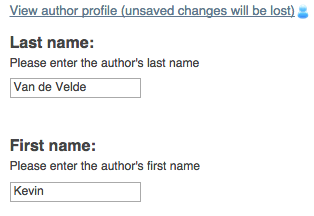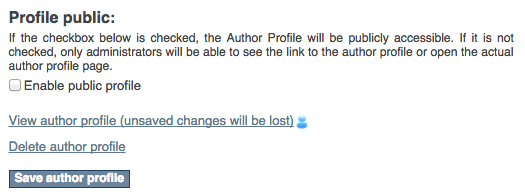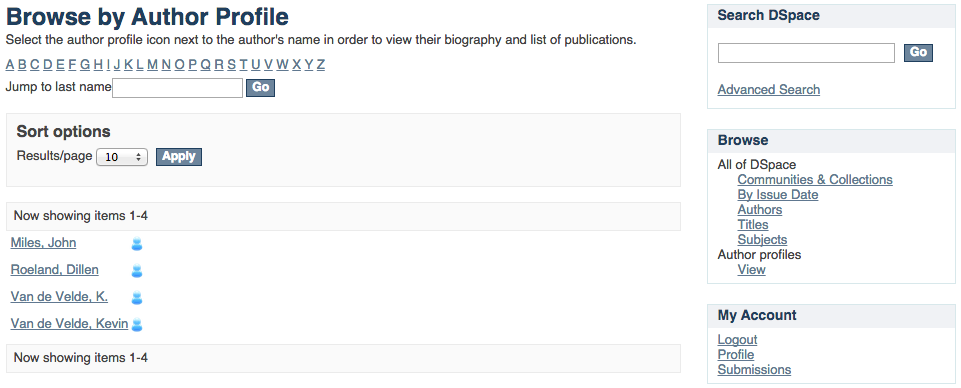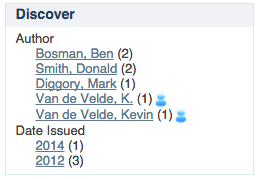Page History
| Table of Contents | ||||||
|---|---|---|---|---|---|---|
|
Introduction
This An author profile is a template page for a new DSpace contribution. If you are unsure about the appropriate format or content, just look at this example. This page can be copied and used to fill out your new documentation.
Make sure you do NOT use Heading level 1, and stick to level 2 as the highest level in your document. Level one is reserved for the top level headings in the PDF version of the documentation.
...
| title | How to use info boxes |
|---|
...
page that showcases the author’s biography and provides links to content that the author contributed to.
Features
- A web user interface where administrators can create, update and delete author profiles
- Author profiles can be created for any author appearing in the DSpace metadata, it is not bound to EPeople (user accounts).
- A separate entry in the public DSpace navigation "View author profiles" that lists the created author profiles. This is parallel to the existing "browse by authors". Browse by authors will still show all metadata entries for authors, while the "view author profiles" only lists those authors for which a profile has been created.
- An icon that shows up in the Discovery author facet to give users easy access to author profiles when searching
| Tasklist | ||||
|---|---|---|---|---|
| ||||
||Completed||Priority||Locked||CreatedDate||CompletedDate||Assignee||Name|| |F|M|T|1389620440889| |bram|Use Case and high level benefits. Can someone with limited technical background understand what this is about?| |F|M|T|1389620638059| |bram|Step by step how to use. Can someone with limited technical background use the feature?| |F|M|T|1389620491621| |bram|Technical implementation details. Did you provide enough details for other developers to add or extend on your work?| |F|M|T|1389620524789| |bram|Configuration. Did you describe which aspects of your contribution can be configured and where configuration happens?| |F|M|T|1389620576924| |bram|Template text cleanup. Have you removed the template text that was initially included on this page?| |F|M|F|1389620841679| |bram|Installation details. If your functionality will not be enabled by default in DSpace, provide details on how the functionality can be installed or enabled.| |
...
Describe which need the contribution is fulfilling and why it was originally created. Screenshots are always nice and will make people enthusiastic about your contribution.
Installation
If it takes any work to enable the contribution, please elaborate in detail. It is recommended that you provide a good default configuration so that your configuration can run straight out of the box.
Technical Implementation Details
If there are any possibilities to customize the contribution, it is good to provide some details on your implementation, or which design decisions have been taken.
| Warning |
|---|
Is enabled by default in the current pull request, but this could change, if it does we need to add install documentation. |
Working with author profiles
Creating an author profile
| Info |
|---|
Only members of the Administrative group can create author profiles, this was done because at the moment there is no way to link a certain author metadata value to a registered user account. |
When logged in as administrator the "Create new author profile" link becomes available in the sidebar. This link directs the administrator to the 'Create new author profile' page, displayed below. The semantics of each field are explained on the page. The fields 'Last name', 'First name', 'Author values used for finding records' and 'Email address' are required. The other fields are optional by default (this can always be changed in the configuration).
Editing author profiles
Once an author profile has been created it will become available on the following pages:
- Item pages
- Search results
- Faceted navigation
Author profiles can be reached by clicking on the author icon located next to the author's name. Non administrative users will only have access to the public profiles. An administrator can edit an author profile by navigation to the author profile and clicking the Edit this author profile link.
When an administrator is editing an authors profile a link will be added on top of the page that will allow the administrator to view the profile with the changes made (unsaved changes will be lost).
Deleting an author profile
When logged in as administrator go to the edit page of an author profile, at the bottom below the save button there will be link with which you can delete an author profile.
Displaying author profiles
Author profile "home" page
The main view displaying an author profile is shown below, it displays not only the author profile but also all submissions in which the person was author or coauthor.
Author profile browse page
The browse by author profiles link is available in the Browse sidebar. The browse by author profile view offers all available author profiles. Private author profiles will only be displayed if the logged in user belongs to the Administrative group.
Discovery author sidebar facet
When the sidebar facets are displayed the author profile icons are displayed next to the authors that have an author profile.
Technical Implementation Details
| Warning | ||
|---|---|---|
| ||
If your contribution is known to be untested or incompatible with certain parts of DSpace, for example JSPUI/XMLUI, Oracle, ... highlight it in a warning like this. Warnings can be found under Insert > Other Macros |
Sub headings are generally fine
Recommended so that people can easily navigate using the Table of Contents at the top.
but don't
drive it too far
Heading 5 is generally not used and has no visual difference with heading 4. When in doubt, don't use Heading lvl 5.
Configuration
Author profiles is currently only available for the XMLUI. |
DSpace core model changes
Before author profiles the DSpace domain (DSpace Objects) consisted of the following objects: Community, Collection, Item, Bundle, Bitstream (a file), Group & EPerson. All these core domain objects have metadata and authorization policies can be linked to these objects.
By creating a new DSpace Object class AuthorProfile we could keep the author profile table very lightweight. The table author profile only contains an identifier, this identifier is then used to link to authorizations policies & metadata. An additional database table is used to link the author profile picture to a bitstream.
Configuration
The fields which can be entered in the edit profile page can be edited in the dspace.dir/config/spring/author-profile-edit-page.xml file. This configuration file allows you to indicate which fields are required, repeatable, add new fields, ...
| Warning | ||
|---|---|---|
| ||
TODO: Discuss the configuration in detail |
Explain which configuration parameters are available, in which files they can be found and which procedure is required for updating. Does it require a rebuild or is a tomcat restart enough, etc?
Where should I put my page? (DELETE this section from template when finished)
...





